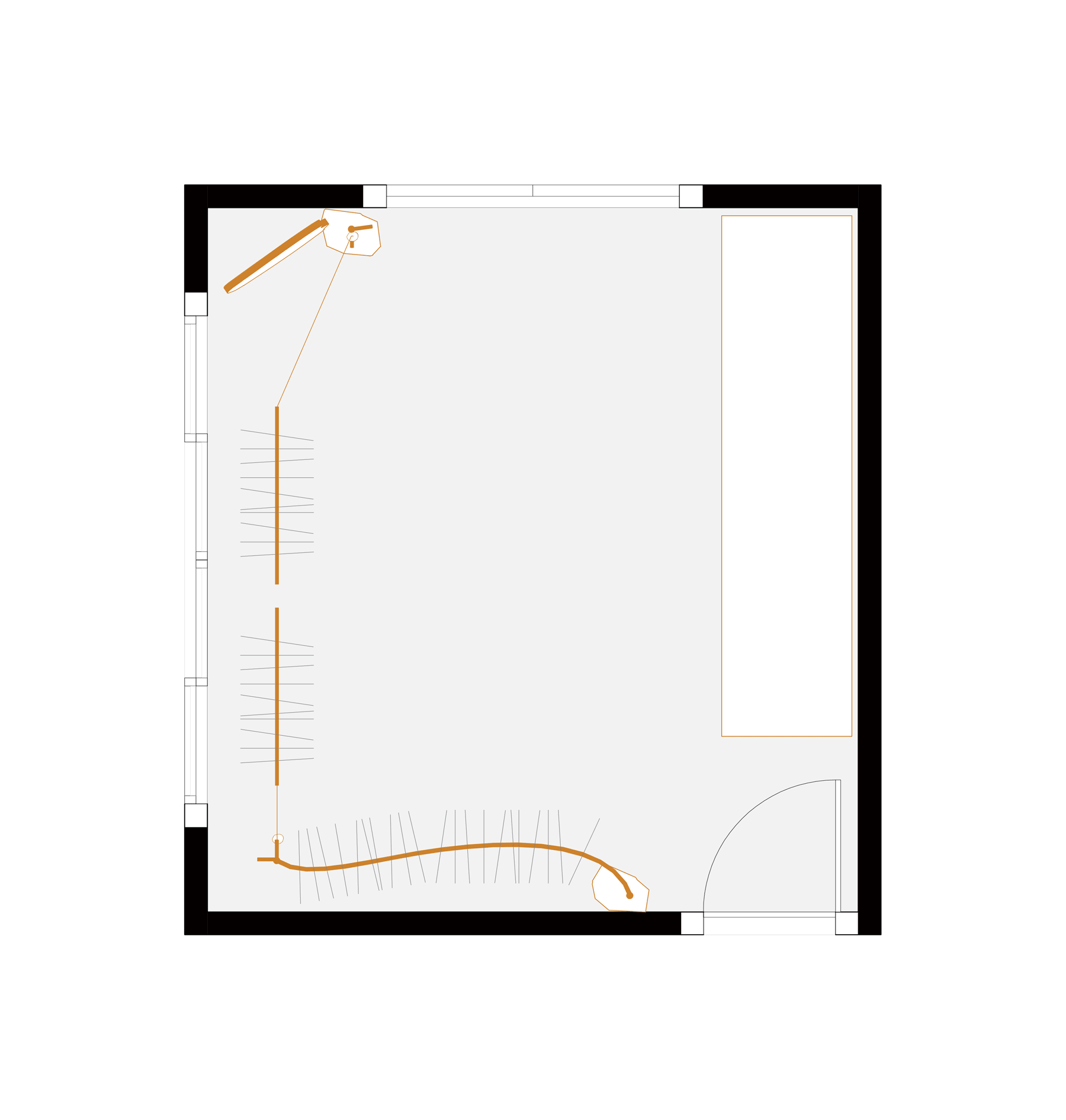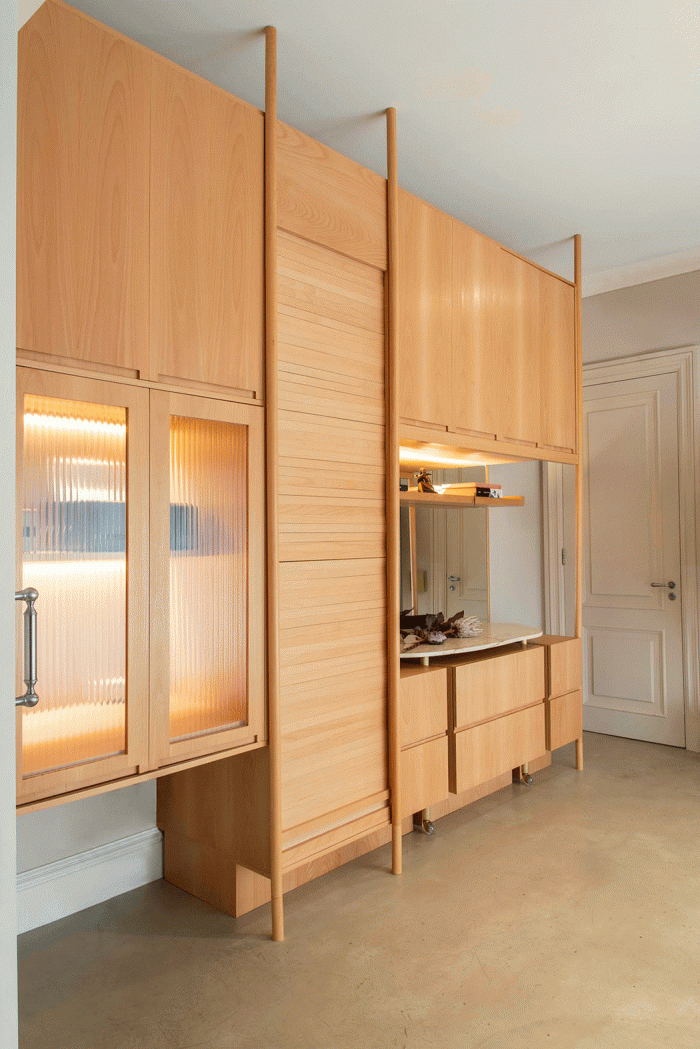Carol Arbex的展览空间和商店改造项目是基于将品牌的身份转化为空间体验的前提下开发的。元素和材料的选择是为了暗示一个微妙的路径,并提供一个个人和主观的叙述–通过用户与空间的相遇来建立。
Carol Arbex’s exhibition space and store renovation project was developed based on the premise of translating the brand’s identity into a spatial experience. Elements and materialities were selected to suggest a subtle path and provide a personal and subjective narrative — built by the user’s encounter with space.

在一个17平方米的空间内,体验被分为三个时刻:当从主通道进入时,木工的家具–包括行政、财务和库存程序–然后,接着是展示系列服装的衣架。最后,一面大镜子设置了一个沉思的雕塑元素,用户、衣服和空间在这里得到了反映。
Within a space of 17m2, the experience is divided into three moments: when entering through the main access, the furniture in carpentry — which includes the administrative, financial, and stock program — then, followed by the clothes rack that displays the collection’s clothes. In the end, a large mirror sets up a sculptural element of contemplation where the user, clothing, and space are reflected.

在概念之外,空间仍然应该回答一个非常实用的要求:在不同的时间,能够容纳四种类型的项目:商店、陈列室、库存和餐厅。这种用途的多样性要求我们把元素看作是能使空间扩展和收缩的装置–适合木工家具的移动台面,根据需要上下移动的衣架,在同一个房间里实现多种场景。
Beyond the concept, space should still answer a very pragmatic demand: to be able to accommodate, at different times, four types of programs: store, showroom, stock, and dining room. This diversity of uses required us to think of elements as devices that enable the expansion and contraction of space — a mobile countertop that fits the furniture in carpentry, clothes rack that go up and down according to their needs, materializing multiple scenarios in the same room.
木工家具有两种开放配置:内置轨道的折叠门和内置垫子–允许在使用过程中,所有的门完全打开并进入家具,防止它们在环境中占据投影空间。家具的设计是为了避免单一的效果,并保证其元素的柔软性和轻盈性–包围办公区的波纹玻璃门,以及支撑镜子、架子和移动台面的空隙。
The furniture in carpentry has two opening configurations: folding door with built-in rail and built-in mat — allowing that during the use, all doors open fully and enter the furniture, preventing them from occupying projection space in the environment. The design of the furniture was designed in such a way as to avoid a monolithic effect and guarantee softness and lightness from its elements — the corrugated glass door that encloses the office area, as well as the void that supports the mirror, shelf, and mobile countertop.
衣架应该给空间带来微妙和动态,为此,拉丝钢件在手动日历机中被弯曲,配置出更多有机的元素,并给展示的衣服带来运动。为了降低成本–但仍然能够使用精致的材料–当地大理石公司丢弃的石头被用来构成基础、衣架的把手和移动台面的支撑面。
The clothes racks were supposed to bring subtlety and dynamics to space, and for that, the brushed steel pieces were curved in a manual calendar machine, configuring elements of greater organicity and giving movement to the displayed pieces of clothing. In order to reduce costs — but to still be able to work with exquisite materials — stones discarded by a local marble company were used to compose the foundation, handles of the clothes racks, and support surface for a mobile countertop.
较大的黄砂岩块被钻得足够深,以便安装和固定衣架的垂直支架(Ø38毫米的管状型材)–以一种块状物的重量作为它们的锚。更小的木块被雕刻、打磨和钻孔,作为移动衣架的把手–其系统与固定滑轮和配重一起工作。所使用的大理石克雷马象牙板是完全不规则的,为此,它被切割在完整的周边,然后固定在商店的移动台面的结构上。
The larger blocks of yellow sandstone were drilled deep enough for the vertical supports of the clothes racks (Ø38mm tubular profile) to be fitted and fixed — in a way that the weight of the block acts as an anchorage for them. Smaller blocks were sculpted, sanded, and drilled, serving as handles for the mobile clothes racks — whose system works with fixed pulleys and counterweights. The marble crema ivory plate that was used was totally irregular and for this reason, it was cut inside the intact perimeter of the piece, and then fixed on the structure of the mobile countertop of the store.
在设计和执行过程中,我们了解到,大理石的生产和处理链–其废物的回收只适用于某些类型的石材和激烈的加工过程–在建筑中呈现出其他的再利用方式,有不同的规模和用途,来自小型制造商,技术上更容易获得。
During the design and execution process, we understand that the production and disposal chain for marble — whose recycling of waste is only possible for certain types of stone and under processes of intense machining — presents other ways of reuse in architecture, with diverse scales and uses from small manufactures, technically more accessible.
Architects: RUÍNA
Area: 17 m²
Year: 2019
Photographs: Lauro Rocha
Manufacturers: AutoDesk, Adobe, Delidecor Cortinas e Persianas, Espaleti Serralheria Artística, Manoel Messias – WMS Marcenaria, Office, Pedras Bellas Artes, R&A Pinturas, Robson Soares, Trimble
Project Team:Julia Ferreira Peres e Victoria Braga
Clients:Loja Carol Arbex
City:São Paulo
Country:Brazil



















